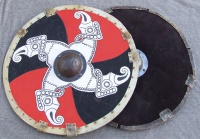Centre boss
A centre-boss shield was a type of round or oblong shield common in period. It has called a centre-boss because of the single central grip, protected by a metal boss. Most centre-boss shields actually had a hole in the centre with the grip flush to the shield, with the protective boss projecting outward from the shield face itself. Most centre-boss sheilds appear to be flat, but the best-quality centre-boss sheilds were lenticular (lens-shaped), that is, having a slightly conical shape back from the centre boss itself. As extent curved planks of wood for shields have been found with wooden shield bosses and flat boards with decorated iron bosses, personal or regional preferences may have dictated shape.
Lenticular centre-boss shields had the benefit of structural strength in addition to the resiliency of wood and rawhide, in the same way that a dome is stronger than a flat roof.
Historically these shields had metal or wooden bosses in the centre riveted to the wooden planked body which could be up to 95cm in diameter. Behind the shield is a wooden (sometimes covered in a metal sheath) or metal crossbar to act as a handle. The grip might also be covered in leather and the ends of the [[handle[[ might have a bronze termini. The face and back of the shield could be covered in leather or rawhide and painted. Housecarls were specifically instructed not to use leather from sheep for this purpose. Guiges were most commonly attached using rings and eyelets.
Centre-boss shields were commonly used by the Anglo-Saxons and Norse, but were known across the medieval world.
Centre Boss Shields in Combat
Centre-boss shields are handled very differently from other shield types (such as the kite shield or the heater shield) which are strapped to the arm. Tending to be light-weight, a centre-boss shield can be "punched" towards an incoming blow.
Some people indicate that a shield should be as heavy as the wielder can carry, others recommend a lighter weight for movement reasons. Lighter weight shields tend to flex more in combat thus preserving the edge for longer than a stiffer shield.
In the event of the shield be destroyed the centre can still be used in the manner of a buckler.
Centre boss shields are very good in a shield wall as their flat face makes for a quick and easy overlap. If you overlap the next shield in the wall so that the inside edge of the shield (the same edge as of the shield as your weapon hand) is overlapped in front of the next shield you are able to open your shield if need be to step forward to attack and you are given maximum protection from right handed spearmen.
